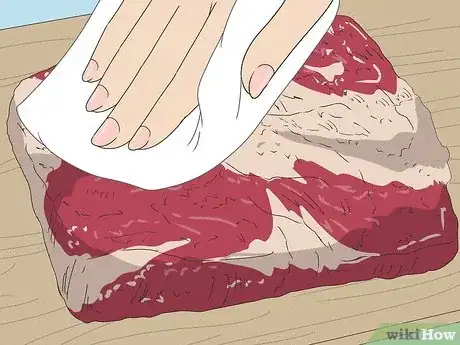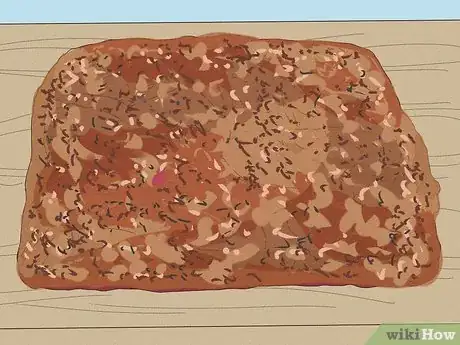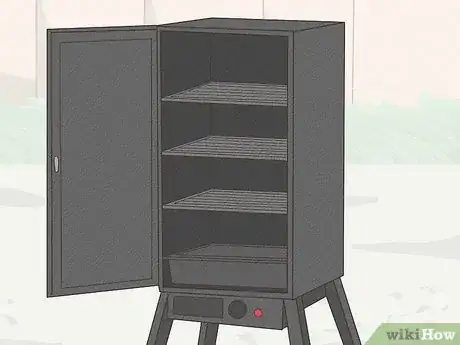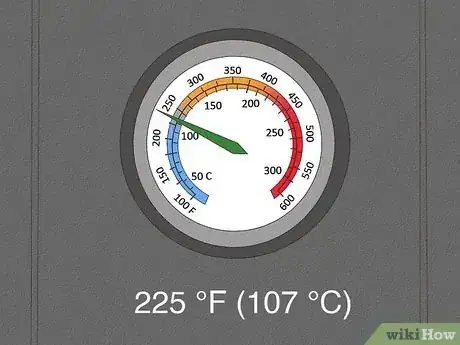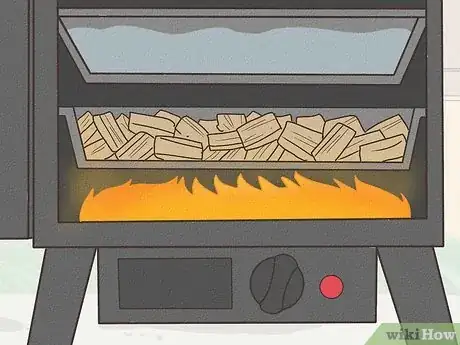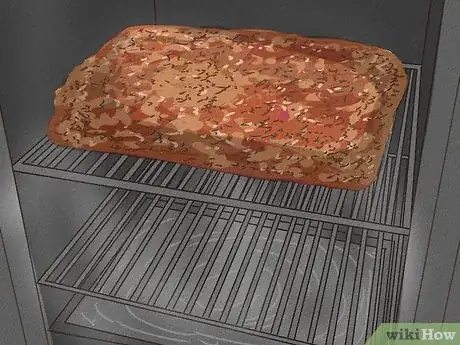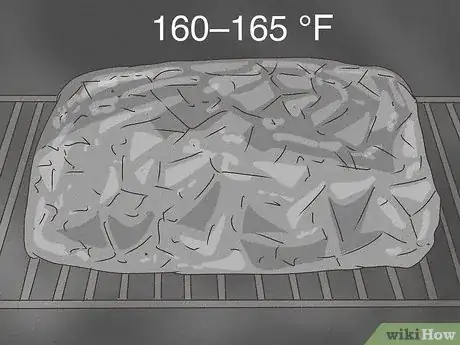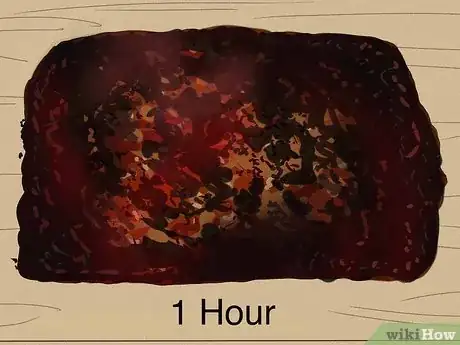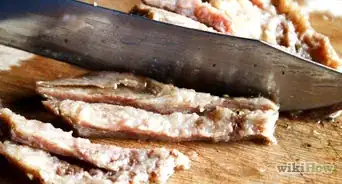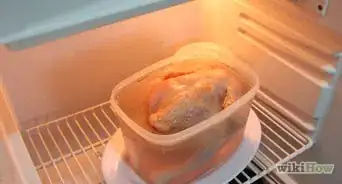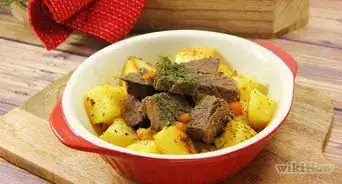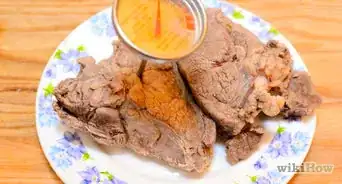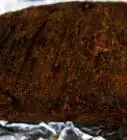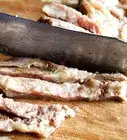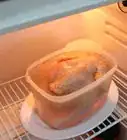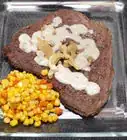This article was co-authored by Joshua & Jeremy George and by wikiHow staff writer, Eric McClure. Joshua and Jeremy George are BBQ Specialists and the Co-Owners of Smokin J’s BBQ in San Diego, California. With over six years of experience, they specialize in slow-smoked meats and making in-house rubs and sauces. Smokin J’s BBQ has been featured in many publications, including The BBQ Magazine.
There are 13 references cited in this article, which can be found at the bottom of the page.
This article has been viewed 420,277 times.
We know it can be daunting to pick up a nice, fancy brisket and then fire up the smoker for the first time. You’d be surprised how easy this is going to be! Yes, smoking a brisket at home can be time-consuming, but the actual work is really straightforward. In this article, we’ll show you how to prepare a brisket and walk you through the smoking process in easy-to-follow steps, the same exact way a professional pitmaster would.
Things You Should Know
- Trim the excess fat, season your brisket liberally, and inject the meat with a brine or marinade to prep a brisket for smoking.
- Preheat your smoker to 225 °F (107 °C) and smoke your brisket for 90 minutes per 1 lb (0.45 kg) of meat.
- Once the internal temperature reaches roughly 160 °F (71 °C), wrap your brisket in foil or butcher paper to help the meat retain moisture.
- Stop cooking the meat once your brisket reaches an internal temperature of 200–210 °F (93–99 °C).
Steps
Trimming & Seasoning
-
1Pat your brisket dry with paper towels. Take your beautiful cut of meat out of the packaging and set it out on the counter. Wash your hands and then grab some paper towels. Gently pat the brisket down to remove any surface moisture.[1]
- It doesn’t need to be bone dry. Brisket is 70% water to begin with, but drying will make the meat easier to handle, clean, and season.
- This is going to take roughly 12-18 hours depending on the size of your brisket, so set aside some time (it’ll be worth it though!). Feel free to complete some of these steps the day before you plan on doing the actual smoking.
-
2Cut the excess fat off of your cut with a curved boning knife. Carefully begin trimming the white, fat deposits on the meat. Trim back as much fat as you can. Stop once you have 1⁄4 in (0.64 cm) layer of fat left on the meat or less, since that will just melt off.[2]
- Some BBQ fiends love the flavor and texture of the fat and don’t remove it all. You want most of it off for a traditional brisket, though.
- Pitmasters will come to blows arguing over how much fat you should leave on brisket for ideal taste. Don’t overthink it. You won’t ruin your brisket by leaving some fat (or removing all of it).
- Remove any stray pieces of brisket that hang off of the meat to prevent them from falling off and igniting in the smoker.
Advertisement -
3Coat your meat liberally with your preferred seasoning. Traditional Texas-style brisket is exclusively dry-rubbed with salt and pepper.[3] Another popular option is to rub brown mustard into the meat and then season it. This will lock in some moisture and give the meat a sweet and tangy flavor. Cover your brisket thoroughly in the seasoning you’d like to use.[4]
- If you think you’ve used enough of your seasoning, you probably want to add more. It takes a very long time for brisket to cook, and a lot of that seasoning will burn up.
- Other popular seasoning ingredients include brown sugar, chili powder, cumin, oregano, cumin, paprika, and cinnamon.
- BBQ nerds get very creative and innovative with their spices and everyone has their own opinions, but there’s no way to go wrong here. Choose whatever spices you enjoy!
-
4Inject the meat with a brine or marinade for a zestier flavor. This is optional, but injecting the meat will make it softer, more tender, and moist.[5] For a basic injection add a few spoonfuls of red wine vinegar to apple juice. Mix them together, load a food syringe, and then inject each portion of the brisket cut.[6]
- Use about 1 fl oz (30 mL) per 1 lb (0.45 kg) of meat.[7]
- The classic injection brine is apple juice and a few tablespoons of vinegar. Other common ingredients include salt water, beef stock, butter, and Worcestershire sauce.
- Avoid using really strong spices and ingredients, like garlic, paprika, cumin, or clove. They can overwhelm the natural meat flavors. The injection should compliment the meat, not overpower it.
-
5Let the brisket rest for at least 1 hour. This will give the seasoning and juices time to really soak into the meat. It will also allow the meat to evenly warm up (or cool off, if you’re refrigerating) so that the temperature is stable when it’s time to cook.[8]
- This is a good spot to take a break if you’re breaking this up into a 2-day process. Cover the brisket with plastic wrap and leave it in your fridge for 24-48 hours.
Smoking
-
1Light charcoal in your chimney starter to start the smoker. Put on heat resistant gloves. If you have a gas or electric smoker, you can simply turn the smoker on. For a traditional smoker grill though, set your chimney starter on the grate and fill it with charcoal. Light some newspaper under the chimney and wait 15 minutes for the charcoal to ignite. Once the coals are hot, release them into the smoker’s pit.[9]
- If you don’t have a smoker, you can use your oven to smoke brisket by putting the brisket on the top rack with a pan filled with water and liquid smoke underneath.
- Don’t use starter fluid. As tempting as it can be to get this process moving quickly, the fluid will leave a chemically aftertaste on your meat.
-
2Preheat your smoker to 225 °F (107 °C) to keep things easy. If you have an electric or gas smoker, simply turn the dial to the proper temperature. With an old school smoker, use the two temperature probes to track and monitor the temperature. Adjust the airflow as needed by introducing more or less air to raise or lower the temperature.[10]
- Temperature is another one of those topics that meat lovers will shout and opine about if you ask them for the “right” temp. Opinions generally range from 200–250 °F (93–121 °C), so just split the difference for your first time.
-
3Set a drip pan filled with water under the top grate. On the grate underneath the brisket, fill an aluminum drip pan with 1 US gal (3.8 L) of water. This will create steam, which will make it easier for the smoke to penetrate your brisket. It will also keep the brisket hydrated, which can be difficult for this cut of meat.[11]
- Do not position the pan directly over the hottest portion of the coals. That will cause the water to evaporate quickly, which you don’t want.
- Check the water level and refill it as needed every time you go to check on the brisket.
-
4Add a small container of wood chips next to the water. Grab an aluminum container and fill it with 2-3 handfuls of wood chunks or chips. Set the container next to your water, closer to the hottest portion of the charcoals. The wood will heat up and slowly burn, producing the smoke you need to infuse the brisket with that classic flavor.[12]
- Use hickory chips if you want that signature, roadhouse-style BBQ flavor.
- Mesquite, Oak, and Apple chips are also popular options that produce their own unique flavors.
- Soak your hardwood chips in water before using them for smoking will keep brisket from drying out.
-
5Set the brisket on the rack with the flat, fatter side up. Carefully position your brisket over the charcoal briquettes. Orient the brisket so that the side that had all of the fat on it is on top. Any remaining fat will melt into the meat and form a beautiful crust on top.[13]
-
6Cover the brisket and smoke it for 90 minutes per 1 lb (0.45 kg) of meat. How long you cook the brisket depends on its weight. Since you’re going “low and slow” here, the heavier and thicker your cut is, the longer it will take for the internal temperature to rise. Depending on your cut, you may need to cook the brisket for 6-18 hours.[14]
- So, for example, if you have a 12 lb (5.4 kg) brisket, you’d need to cook it for 18 hours.
- If you’re using a traditional oven, cook the brisket for 60 minutes per 1 lb (0.45 kg) of meat.
-
7Add more wood chips whenever they stop smoking. Every 45 minutes or so, check in on your smoker to confirm there’s plenty of smoke. If the chips are burnt out entirely, throw on some heat-resistant gloves, open the smoker, and add another handful of wood chips to refresh the smoke.[15]
- If your wood chips have a dash of moisture to them, you may not need to replenish the wood for hours at a time, so don’t worry about anything being wrong if the smoke persists.
-
8Wrap the brisket in foil once the internal temp hits 160–165 °F (71–74 °C). Brisket begins to dry out at 160–165 °F (71–74 °C), so use a meat thermometer to monitor the brisket as it cooks. Once it hits the drying-out range, throw on some heat resistant gloves and open your smoker. Use tongs to remove the brisket, set it on a sheet of aluminum foil or butcher paper, and fold the meat tightly by hand before putting it back.[16]
- This is another one of those “pitmasters have opinions” decisions. While some folks swear foil, butcher paper, or pink barbeque paper, they’ll all work to trap moisture and keep your brisket delicious!
- This is known as the “Texas Crutch.” It’s technically optional, but this is one of those “trust us, it’s worth it” things.
-
9Remove the brisket from the smoker once the meat reaches 200–210 °F (93–99 °C). Once you start approaching the cooking time based on the 90 minutes per 1 lb (0.45 kg) rule, use your meat thermometer to check the internal temperature of the thickest part of the meat. Once you reach 200–210 °F (93–99 °C), use tongs or a large spatula to remove the brisket from the smoker.[17]
- Brisket is not safe to eat if the internal temperature of thickest portion doesn’t reach at least 200 °F (93 °C).
Serving the Brisket
-
1Rest the brisket for at least 1 hour after it finished cooking. After 6-18 hours of work, we understand that you’ll be on the edge of your seat waiting to try the brisket. Still, wait at least 1 hour. This relaxes the meat and allows the juices to soak into the fibers of the brisket. Just keep the brisket wrapped in its foil or paper and leave it on the counter for at least 60 minutes.[18]
- Some pitmasters will cover the wrapped brisket with a towel as it rests to keep it from cooling too quickly.
-
2Carve the brisket against the grain with a carving knife. Cutting and serving brisket is pretty straightforward compared to the rest of the process. Just set the brisket out on a cutting board and use a slicing knife to cut the brisket into strips that are roughly the width of a pencil. Use your tongs to plate the brisket.[19]
-
3Pour your sauce on top or toss the brisket slices in it if you’d like. You can either make your own BBQ sauce or purchase a premade sauce. Plate your brisket and squirt or spread your sauce on top, or throw a few strips of brisket in a mixing bowl and toss the meat by hand before plating it. You can also simply enjoy the brisket Texas-style (which means no sauce at all).[20]
- Meat enthusiasts will lose their mind over store-bought sauce. If you want to just add a few squirts of Heinz or Sweet Baby Ray’s, do it. Don’t let anyone sauce shame you.
- Many people simply enjoy a few squirts of mustard on top of brisket.
- There’s no wrong way to enjoy brisket. Sauce, no sauce, whatever—eat your homemade brisket and enjoy it however you’d like.
Community Q&A
-
QuestionOn a pellet smoker, do you lay the brisket on the grate or put in on the racks?
 wikiHow Staff EditorThis answer was written by one of our trained team of researchers who validated it for accuracy and comprehensiveness.
wikiHow Staff EditorThis answer was written by one of our trained team of researchers who validated it for accuracy and comprehensiveness.
Staff Answer wikiHow Staff EditorStaff AnswerYou can do either. You can put the brisket on the racks and then put your wood chips and water pan on the grate, which will result in a softer crust. Alternatively, you can put the chips and water next to the brisket on the grates, which will give you a firmer crust.
wikiHow Staff EditorStaff AnswerYou can do either. You can put the brisket on the racks and then put your wood chips and water pan on the grate, which will result in a softer crust. Alternatively, you can put the chips and water next to the brisket on the grates, which will give you a firmer crust. -
QuestionCan I cut the brisket in half before cooking?
 Community AnswerYes. It may cook faster that way too.
Community AnswerYes. It may cook faster that way too. -
QuestionYou said to rotate the meat, did you mean flip it over? If not, what is the point of rotating it?
 Community AnswerDo not flip over. Just rotate it on the rack to ensure even cooking. Keep the fat side up to allow the meat to remain juicy.
Community AnswerDo not flip over. Just rotate it on the rack to ensure even cooking. Keep the fat side up to allow the meat to remain juicy.
Things You'll Need
- Brisket
- Rub or marinade ingredients
- Aluminum foil, butcher paper, or barbeque paper
- Smoker or grill
- Wood chips
- Grill tongs
- Heat resistant gloves
- Meat injector
- Cutting board
- Boning knife
- Carving knife
References
- ↑ https://www.bhg.com/recipes/how-to/cooking-basics/how-to-cook-brisket/
- ↑ https://www.foodrepublic.com/2017/12/08/smoke-brisket-indoors/
- ↑ https://www.seriouseats.com/sous-vide-barbecue-smoked-bbq-brisket-texas-recipe
- ↑ https://grillmasteruniversity.com/brisket-rub-mustard/
- ↑ https://www.seriouseats.com/sous-vide-barbecue-smoked-bbq-brisket-texas-recipe
- ↑ https://bbqchamps.com/how-to-inject-brisket/
- ↑ https://justcook.butcherbox.com/how-to-prepare-and-cook-brisket-for-the-first-time/
- ↑ https://bbqchamps.com/how-to-inject-brisket/
- ↑ https://www.epicurious.com/expert-advice/how-to-use-a-smoker-grill-step-by-step-article
- ↑ https://www.nytimes.com/2019/05/24/dining/smoked-brisket.html
- ↑ https://bbqhost.com/water-pan-for-brisket/
- ↑ https://www.epicurious.com/expert-advice/how-to-use-a-smoker-grill-step-by-step-article
- ↑ https://www.bhg.com/recipes/how-to/cooking-basics/how-to-cook-brisket/
- ↑ https://thegrillingdad.com/how-to-grill/beef/how-long-to-smoke-a-brisket-per-pound/
- ↑ https://barbecuefaq.com/how-often-to-add-wood-chips-to-electric-smoker/
- ↑ https://www.chicagotribune.com/dining/craving/ct-food-0916-texas-crutch-20150904-story.html
- ↑ https://justcook.butcherbox.com/how-to-prepare-and-cook-brisket-for-the-first-time/
- ↑ https://www.nytimes.com/2019/05/24/dining/smoked-brisket.html
- ↑ https://www.nytimes.com/2019/05/24/dining/smoked-brisket.html
- ↑ https://www.eater.com/2016/6/18/11966056/barbecue-sauce-styles
About This Article
Before smoking brisket, buy meat that is fresh and has some fat marbling in it. Prepare it by trimming the fat to 1/4 inch thick and rubbing it with spices before leaving it in the refrigerator overnight. Get your grill ready by spreading out the hot coals and placing soaked hardwood chips over them. Then put the meat on the grill with the fat side up and cook it while maintaining the grill temperature at 200 °F. When the inside temperature of the meat is 185 °F, remove it from the grill and let it rest before slicing. To learn how to buy the tastiest, juiciest brisket, read on!
